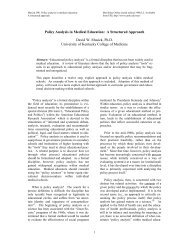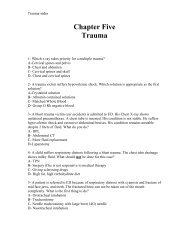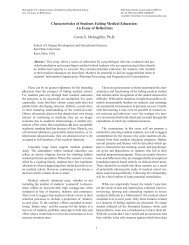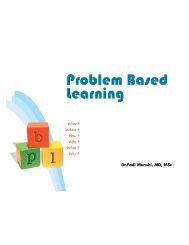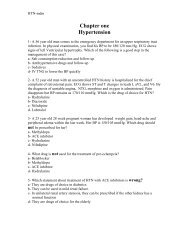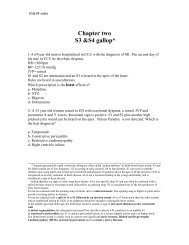Sustaining Interest During Lectures with the use of Multimedia Erle ...
Sustaining Interest During Lectures with the use of Multimedia Erle ...
Sustaining Interest During Lectures with the use of Multimedia Erle ...
Create successful ePaper yourself
Turn your PDF publications into a flip-book with our unique Google optimized e-Paper software.
Lim EC, Ong BK, Wilder-Smith EP, Seet RC. Med Educ Online [serial online] 2006.<strong>Sustaining</strong> interest during lectures <strong>with</strong> <strong>the</strong> <strong>use</strong> <strong>of</strong> multimedia.Available from http://www.med-ed-online.org<strong>Sustaining</strong> <strong>Interest</strong> <strong>During</strong> <strong>Lectures</strong> <strong>with</strong> <strong>the</strong> <strong>use</strong> <strong>of</strong> <strong>Multimedia</strong><strong>Erle</strong> Chuen-Hian Lim, Benjamin KC Ong, Einar PV Wilder-Smith, Raymond CSSeet.Yong Loo Lin School <strong>of</strong> Medicine, National University <strong>of</strong> SingaporeKeywords : video, medical education, medical students, survey“A picture paints a thousand words”, goes <strong>the</strong>cliché. Indeed, pictures, in <strong>the</strong> form <strong>of</strong> photographs,charts and diagrams are de rigeur in our daily lives.Newspapers and magazines boast high-resolutioncolored images, as do respected medical journals. 1How much more information, <strong>the</strong>n, can becommunicated by “moving pictures” or videos?A truism is that <strong>the</strong> written word opens new vistas,which are limited only by <strong>the</strong> reader’s imagination.Purists boycott movie adaptations <strong>of</strong> <strong>the</strong>ir belovednovels, decrying <strong>the</strong> crass commercialization andlack <strong>of</strong> soul that cheapens <strong>the</strong> beauty and grandeur <strong>of</strong><strong>the</strong> written word. Yet, one has only to watch <strong>the</strong>Harry Potter or Lord <strong>of</strong> <strong>the</strong> Rings films to realize thatmovies, in bringing prose to life, really are magic.Some medical journals have appreciated thisphenomenon and have begun to include online orhard-copy videotape reports.To quote 19 th century American <strong>the</strong>ologian TryonEdwards, "to waken interest and kindle enthusiasm is<strong>the</strong> sure way to teach easily and successfully". Acolleague, inspired by this, gave a lecture replete <strong>with</strong>jokes, pictures and animations. He came away,satisfied that it had gone well, judging by how <strong>the</strong>students had participated fully, laughed in all <strong>the</strong>right bits and applauded him at <strong>the</strong> end. It was onlywhen he administered a pop quiz <strong>the</strong> next day that herealized that <strong>the</strong> students had not absorbed <strong>the</strong>contents <strong>of</strong> <strong>the</strong> lecture at all!Few would dispute that to be effective, <strong>the</strong>speaker has to engage his listener. No one listens to abore who, though brilliant, will likely be ignored byor disenchant his somnolent audience and thusremain uncelebrated. A tongue-in-cheek article byRockwood examined <strong>the</strong> incidence <strong>of</strong> physiciansnodding <strong>of</strong>f at scientific sessions, and concluded thatcertain characteristics predisposed one to nodding<strong>of</strong>f. These include monotonous tone <strong>of</strong> voice, poorslide quality and a tendency to ramble. 2The Confucian dictum, “Tell me, and I will forget.Show me, and I may remember. Involve me, and Iwill understand”, is said to have influenced <strong>the</strong>formulation <strong>of</strong> <strong>the</strong> experiential learning cycle <strong>of</strong>David Kolb. 3 The cycle basically refers to <strong>the</strong> processby which we attend to and understand ourexperiences in order to learn from <strong>the</strong>m. Paired <strong>with</strong><strong>the</strong> Kolb Learning Style Inventory (LSI), whichmeasures preference for each <strong>of</strong> four learningorientations, viz abstract conceptualization(thinking), concrete experience (feeling), activeexperimentation (doing) and reflective observation(watching), 4,5 it has been argued that teaching andlearning environments, if matched <strong>with</strong> <strong>the</strong> individuallearning styles <strong>of</strong> students, could greatly enhanceeducational outcomes in medical schools. 6,7 The firsttwo orientations describe modes <strong>of</strong> acquiring newinformation, whereas <strong>the</strong> latter two describe <strong>the</strong>preferred modes <strong>of</strong> incorporating new information. 8The LSI defines four discrete learning styles:convergers, assimilators, divergers andaccommodators, based on <strong>the</strong>ir combination <strong>of</strong>methods <strong>of</strong> acquiring and incorporating information.Judicious inclusion <strong>of</strong> videotaped vignettes (videos),it might be argued, would allow for an experientialelement to <strong>the</strong> teaching process. For example, instead<strong>of</strong> describing choreiform movements in words alone,<strong>the</strong> inclusion <strong>of</strong> a videotape assessment <strong>of</strong> a patient<strong>with</strong> chorea, coupled <strong>with</strong> a text descriptor, wouldprovide a “tie-in” to complete <strong>the</strong> experience for <strong>the</strong>student. We re-examined how lectures were given atour university, and felt that adding multimediapresentations in <strong>the</strong> form <strong>of</strong> videos would help ourstudents understand <strong>the</strong> material better.The Neuroscience lecture seriesAt our university, <strong>the</strong> second-year neurosciencemodule consists <strong>of</strong> a series <strong>of</strong> didactic lectures givenby anatomists, neurologists and neurosurgeons. Few,if any, incorporated video presentations, but allcontained figures, charts and photographs. Theteaching <strong>of</strong> neurology is particularly amenable to <strong>the</strong><strong>use</strong> <strong>of</strong> videos, as a fair proportion <strong>of</strong> <strong>the</strong> neurologicalexamination is visual as well as tactile. Evencomponents such as motor power and tone, whichrequire that <strong>the</strong> examiner “feel” <strong>the</strong> response <strong>of</strong> <strong>the</strong>patient, can be discerned by observation as well.<strong>Interest</strong>ingly, some aspects <strong>of</strong> <strong>the</strong> clinical1
Lim EC, Ong BK, Wilder-Smith EP, Seet RC. Med Educ Online [serial online] 2006.<strong>Sustaining</strong> interest during lectures <strong>with</strong> <strong>the</strong> <strong>use</strong> <strong>of</strong> multimedia.Available from http://www.med-ed-online.orgTable 1A Personal Background Male Female1 Gender (n=216) 124 (57.4%) 92 (42.6%)BDo you think thatinclusion <strong>of</strong> videos in <strong>the</strong>lecture help:Male(N=124)Female(N=92)Significance*1Yes No Yes No1 Sustain interest? 100% 0 100% 0 NAn=124n=922 Visualize concepts? 97.6% 2.4% 97.8% 2.2% 0.906n=121 n=3 n=90 n=23 Remember facts better? 76.6% 23.4% 87.0% 13.0% 0.055n=95 n=29 n=80 n=124 Understand better? 95.2% 4.8% 100% 0 *0.032n=118 n=6 n=925 Apply knowledge? 91.9% 7.3% 93.5% 6.5% 0.671n=114 n=9 n=86 n=66 Pass tests/exams? 55.6% 37.1% 65.2% 33.7% 0.147n=69 n=46 n=60 n=31C Would you like to seemore videos in yourlectures?100%n=1240 98.9%n=911.1%n=10.245DA good lecture wouldconsist <strong>of</strong> components in<strong>the</strong> following proportions(total 100%)Male(N=124)Mean (SD)Female(N=92)Mean (SD)Significance*21 Text 37.30 (14.826) 41.09 (14.896) 0.0652 Diagrams/Figures 28.99 (11.348) 26.74 (9.677) 0.1273 Video 33.63 (14.026) 32.17 (14.512) 0.458*1 Pearson chi-square test ; *2 T-test for equality <strong>of</strong> means for independent samplesexamination (e.g. phenomenology <strong>of</strong> movementdisorders or <strong>the</strong> phases <strong>of</strong> a patient’s gait), are bestassessed “at a distance” i.e. on screen as well as at <strong>the</strong>bedside.Student feedback after incorporating videosSoon after incorporating videos in our PowerPointlectures, we noticed that students talked less amongst<strong>the</strong>mselves and appeared to pay better attentionduring <strong>the</strong> lectures. We were heartened, as well,when students provided positive verbal feedback.Realizing that we should enlist <strong>the</strong> opinions <strong>of</strong> our“consumers”, who could provide feedback to help usimprove as lecturers and educationists, we performeda simple survey <strong>of</strong> 216 medical students after anhour-long lecture on movement disorders. Ourquestionnaire consisted <strong>of</strong> 11 questions. In it, weasked if <strong>the</strong>y felt that inclusion <strong>of</strong> videos in lectureshelped sustain interest, visualize concepts, rememberfacts, understand <strong>the</strong> lecture, apply knowledge andpass tests/exams. Finally, we asked if <strong>the</strong>y would liketo see more videos in lectures and what proportion <strong>of</strong>an ideal lecture should consist <strong>of</strong> text, figures anddiagrams and videos. We were aware <strong>of</strong> <strong>the</strong>limitations <strong>of</strong> <strong>the</strong> survey, in that it was limited to oneclass, one field <strong>of</strong> study and one lecture, but felt that<strong>the</strong> feedback would be <strong>use</strong>ful to our performances aseducators.All <strong>of</strong> our students (124 males, 92 females)completed <strong>the</strong> questionnaire. The results aresummarized in Table 1. Students ranged in age from19 to 23. All felt that inclusion <strong>of</strong> videos helped tosustain interest in <strong>the</strong> lecture. 97.7% (211/216)agreed that <strong>the</strong> videos helped <strong>the</strong>m to visualizeconcepts better, whereas only 81% (175/216) felt thatvideos would help <strong>the</strong>m remember facts better.97.2% (210/216) were <strong>of</strong> <strong>the</strong> opinion that <strong>the</strong> videoshelped in <strong>the</strong>ir understanding <strong>of</strong> <strong>the</strong> lecture, and 93%(200/215) saw benefit in terms <strong>of</strong> application <strong>of</strong>knowledge. <strong>Interest</strong>ingly, only 62.6% (129/216)envisaged that videos in lectures would help <strong>the</strong>mpass tests or examinations better, yet all except onefemale student felt that <strong>the</strong>y would like to see morevideos in <strong>the</strong>ir lectures. Approximately a third each2
Lim EC, Ong BK, Wilder-Smith EP, Seet RC. Med Educ Online [serial online] 2006.<strong>Sustaining</strong> interest during lectures <strong>with</strong> <strong>the</strong> <strong>use</strong> <strong>of</strong> multimedia.Available from http://www.med-ed-online.org<strong>of</strong> text, figures & diagrams and text should,according to <strong>the</strong> results <strong>of</strong> our survey, make up <strong>the</strong>ideal lecture. We fur<strong>the</strong>r analyzed <strong>the</strong> results bygender using Pearson’s chi-square test. There was nostatistically significant gender difference, except that100% <strong>of</strong> female students interviewed felt that videoshelped <strong>the</strong>m to understand lectures better, but only95.2% <strong>of</strong> males (118/124) felt <strong>the</strong> same way(p=0.032).What is <strong>the</strong> role for videos in medical education?The <strong>use</strong> <strong>of</strong> videotape presentations in medicine isbecoming increasingly popular, although <strong>use</strong> islargely in distance learning, 9 such as videoconferencingor viewing taped lectures orinformational materials. Time and logisticalconstraints limit <strong>the</strong> provision <strong>of</strong> live patients formedical education, yet <strong>the</strong> honing <strong>of</strong> <strong>the</strong> doctors’skills requires live patient contact, or at least <strong>the</strong>demonstration <strong>of</strong> physical signs or examinationtechniques. Simulation-based medical education(using mannequins, actors posing as patients andvideotape presentations) <strong>of</strong>fers a viable alternative to,but not a replacement for, live patient contact. 10Procedurists (endoscopists and angiographers, forexample) have long <strong>use</strong>d real-time videotransmission for mass education. Conn has reportedhow physicians are increasingly using simulators tohone <strong>the</strong>ir skills. <strong>Interest</strong>ingly, surgeons who playvideo games are purported to work 27% faster andmake 37% fewer mistakes than <strong>the</strong>ir colleagues whodo not. 11 Ernst et al reported <strong>the</strong> successfulpublication, both on <strong>the</strong> Internet and in CD-ROMform, <strong>of</strong> video and digitized images <strong>of</strong> proceduressuch as angiography and colonoscopy, for a first-yeargross anatomy course. 12 A novel video feedbacktechnique has been found to be effective in enhancingmedical communications skills, 13 and <strong>the</strong> <strong>use</strong> <strong>of</strong>patient examination vignettes has been found to beinvaluable for demonstrating signs in various fields inmedicine. 14 This is especially <strong>use</strong>ful for signs whichare rare or ephemeral. Recently, video technology hasbeen harnessed for assessment purposes. Liebermanreported <strong>the</strong> successful introduction <strong>of</strong> video clipsinto computer-based testing for a neurology module,in which examinees were asked to interpretvideotaped examination findings. 15 The RoyalCollege <strong>of</strong> General Practitioners has introduced avideo component in <strong>the</strong> membership examination, inwhich candidates’ consulting skills are assessed via aseries <strong>of</strong> videotaped doctor-patient interactions. 16 Therole <strong>of</strong> multimedia technology in education is beingincreasingly recognized. 17What did we learn from our survey?We sought to assess student perceptions <strong>of</strong> <strong>the</strong>utility <strong>of</strong> videos in lectures. More than 95% <strong>of</strong> <strong>the</strong>216 students felt that videos were <strong>use</strong>ful in sustaininginterest, helping <strong>the</strong>m to visualize concepts,understand better and apply knowledge, while fewerfelt that videos would help <strong>the</strong>m remember facts orpass assessments. Almost all, however, indicated apreference for some proportion <strong>of</strong> videos in <strong>the</strong>irlectures.In addition to <strong>the</strong> limitations described above, oursurvey only indicates <strong>the</strong> attitudes <strong>of</strong> <strong>the</strong> students tovideo presentations, not <strong>the</strong> efficacy <strong>of</strong> lecturesincorporating videos as an educational tool. To dothis, we would have to perform a study in which 2cohorts <strong>of</strong> students are exposed to <strong>the</strong> same lecturecontent, each delivered by <strong>the</strong> same lecturer, one <strong>with</strong>and <strong>the</strong> o<strong>the</strong>r <strong>with</strong>out accompanying complementaryvideos. Following this, an assessment can beadministered to both cohorts, testing <strong>the</strong>irunderstanding and application <strong>of</strong> <strong>the</strong> material taught.Obviously, our survey was not a true representation<strong>of</strong> student attitudes to <strong>the</strong> incorporation <strong>of</strong> videotapedmaterial in lectures, as it was carried out after amovement disorders lecture, a field in which <strong>the</strong>complicated phenomenology is greatly aided byvideos. Certainly, large-scale studies on <strong>the</strong> utility <strong>of</strong>videos in medical education, in different fields, bothpre-clinical and clinical, is indicated.Intriguingly, female students seemed to feel thatvideos helped <strong>the</strong>m understand material better.Gender differences in pedagogy have beendescribed. 18 Intuitively, learning styles might dictatepreference for video inclusion, and it is unfortunatethat we could not administer <strong>the</strong> Kolb LSI to ourstudents prior to <strong>the</strong> survey.ConclusionsWe concluded that videos have a place in medicaleducation, and have increasingly incorporated videos,where suitable, in our lectures. We feel that <strong>the</strong>effectiveness <strong>of</strong> video and o<strong>the</strong>r multimedia aidswould have to be assessed formally. Our surveyindicates that students find that videos enlivenlectures, and <strong>the</strong>y expect to benefit from videos inlectures. Certainly, however, <strong>the</strong>re is no substitutefor good pedagogic techniques and one must not gooverboard and include multimedia such as animationsand video vignettes purely for <strong>the</strong>ir entertainmentvalue. As educators, it behooves us to embracetechnology, especially when it makes us betterteachers and communicators. At <strong>the</strong> same time, wehave to seek <strong>the</strong> counsel <strong>of</strong> our students. To quoteKierkegaard, “Instruction begins when you, <strong>the</strong>3
Lim EC, Ong BK, Wilder-Smith EP, Seet RC. Med Educ Online [serial online] 2006.<strong>Sustaining</strong> interest during lectures <strong>with</strong> <strong>the</strong> <strong>use</strong> <strong>of</strong> multimedia.Available from http://www.med-ed-online.orgteacher, learn from <strong>the</strong> learner, put yourself in hisplace so that you may understand what he learns and<strong>the</strong> way he understands it”.References1. Pritt B, Gibson P, Cooper K, Hardin N.What is a picture worth? Digital imagingapplications in autopsy reports. Arch PatholLab Med 2004;128:1247-50.2. Rockwood K, Hogan DB, Patterson CJ.Incidence <strong>of</strong> and risk factors for nodding <strong>of</strong>fat scientific sessions. CMAJ 2004;171:1443-5.3. Kolb DA. Experiential learning: Experienceas <strong>the</strong> source <strong>of</strong> learning and development.Englewood Cliffs (NJ): Prentice Hall; 1984.4. Kolb DA. Individual learning styles and <strong>the</strong>learning process. Cambridge (MA): MITPress; 1971.5. Smits PB, Verbeek JH, Nauta MC, Ten CateTJ, Metz JC, van Dijk FJ. Factors predictive<strong>of</strong> successful learning in postgraduatemedical education. Med Educ 2004;38:758-66.6. Curry L. Cognitive and learning styles inmedical education. Acad Med 1999;74:409–13.7. Newble DI, Entwistle NJ. Learning stylesand approaches: Implications for medicaleducation. Med Educ 1986;20:162–75.8. Engleberg NC, Schwenk T, Gruppen LD.Learning styles and perceptions <strong>of</strong> <strong>the</strong> value<strong>of</strong> various learning modalities before andafter a 2nd-year course in microbiology andinfectious diseases. Teach Learn Med2001;13:253-7.9. Berner ES, Adams B. Added value <strong>of</strong> videocompared to audio lectures for distancelearning. Int J Med Inform 2004;73:189-93.10. Ziv A, Wolpe PR, Small SD, Glick S.Simulation-based medical education: anethical imperative. Acad Med 2003;78:783-8.11. Conn J. The games doctors play. Physiciansare turning to high-tech simulators topractice <strong>the</strong>ir clinical techniques. Evenvideo-game skills prove valuable in <strong>the</strong> OR.Mod Healthc 2004;34:32-3.12. Ernst RD, Sarai P, Nishino T, Collins T, OtoA, Hernandez A, Walser EM, Chaljub G.Transition from film to electronic media in<strong>the</strong> first-year medical school gross anatomylab. J Digit Imaging 2003;16:337-40.13. Roter DL, Larson S, Shinitzky H, Chern<strong>of</strong>fR, Serwint JR, Adamo G, Wissow L. Use <strong>of</strong>an innovative video feedback technique toenhance communication skills training. MedEduc 2004;38:145-57.14. Welsh CJ. OD's and DT's: using movies toteach intoxication and <strong>with</strong>drawalsyndromes to medical students. AcadPsychiatry 2003;27:182-6.15. Lieberman SA, Frye AW, Litwins SD,Rasmusson KA, Boulet JR. Introduction <strong>of</strong>patient video clips into computer-basedtesting: effects on item statistics andreliability estimates. Acad Med2003;78(Suppl):S48-51.16. McKinstry B, Walker J, Blaney D, HeaneyD, Begg D. Do patients and expert doctorsagree on <strong>the</strong> assessment <strong>of</strong> consultationskills? A comparison <strong>of</strong> two patientconsultation assessment scales <strong>with</strong> <strong>the</strong>video component <strong>of</strong> <strong>the</strong> MRCGP. Fam Pract2004;21:75-80.17. Liaskos J, Diomidus M. <strong>Multimedia</strong>technologies in education. Stud HealthTechnol Inform 2002;65:359-72.18. de Saintonge DM, Dunn DM. Gender andachievement in clinical medical students: apath analysis. Med Educ 2001;35:1024-33.CorrespondenceCorrespondence concerning this article should bedirected to <strong>Erle</strong> Chuen-Hian Lim, M Med (Int Med),Assistant Pr<strong>of</strong>essor, Yong Loo Lin School <strong>of</strong>Medicine, National University <strong>of</strong> Singapore, Division<strong>of</strong> Neurology, National University Hospital, 5 LowerKent Ridge Road, Singapore 119074 or via email tomdcelch@nus.edu.sg.4



